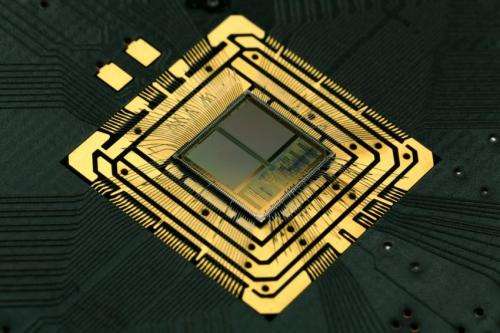November 5, 2014 weblog
Drone in flight test learns on the fly with special chip

The great computer challenge for many scientists centers around how well a computer can learn, react and adapt from the environment. Tom Simonite of MIT Technology Review on Tuesday had a report about recent experiments at corporate and academic labs using neuromorphic chips, with networks of "neurons" that communicate in spikes of electricity. Simonite wrote that some can even automatically reprogram themselves to learn new skills. The latest news, he reported on Tuesday, is that "a neuromorphic chip has been untethered from the lab bench, and tested in a tiny drone aircraft that weighs less than 100 grams." Specifically, the drone was six inches square, 1.5 inches high, and weighed 93 grams, including the battery. The chip used only 50 milliwatts of power (not enough for a conventional computer to run software that could learn to recognize rooms). The chip mounted in the center of the aircraft has 576 silicon neurons. In the test it took in data from sensors—optical, infrared, and ultrasound—as it flew between three rooms.
What happened reflects promising progress in modeling hardware on the brain. Said Simonite: "The first time the drone was flown into each room, the unique pattern of incoming sensor data from the walls, furniture, and other objects caused a pattern of electrical activity in the neurons that the chip had never experienced before. That triggered it to report that it was in a new space, and also caused the ways its neurons connected to one another to change, in a crude mimic of learning in a real brain. Those changes meant that next time the craft entered the same room, it recognized it and signaled as such."
Narayan Srinivasa, director, Center for Neural and Emergent Systems (CNES), which is part of Malibu, California-based HRL Laboratories, said the experiment showed that, while under strict size, weight, and power constraints, on the fly learning was possible.
According to DARPA, "biological neural systems, such as the brain, process large volumes of information in complex ways while consuming very little power. Power savings are achieved in neural systems by the sparse utilizations of hardware resources in time and space. Since many real-world problems are power limited and must process large volumes of data, neuromorphic computers have significant promise."
The flight test was a challenge set by DARPA as part of a project under which it has funded HRL, IBM, and others, said Simonite, to work on neuromorphic chips.
Work continues. IEEE Spectrum said neuroscientists continue to find new things about how networks of real brain cells work on information. Vishal Saxena, an assistant professor working on neuromorphic chips at Boise State University, was quoted as saying, "There's a lot of work to be done collectively between circuit and algorithm experts and the neuroscience community."
More information: — www.technologyreview.com/news/ … ip-takes-to-the-sky/
© 2014 Tech Xplore

















